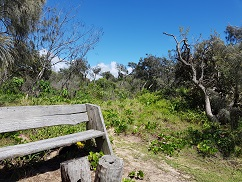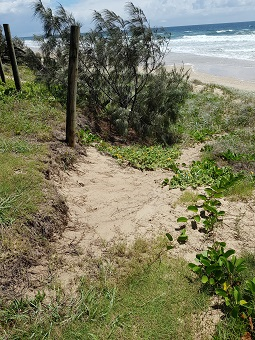
Vegetation damage framed by dying vegetation
Naturally vegetated coast, lake and river foreshores are a green backdrop to our neighbourhoods and provide wildlife habitat and ccontributes to community resilience to the immediate and long-term impacts of climate change. Being a good foreshore neighbour can help keep our public natural areas in good condition now and for future generations.

Private beach access trampling erosion
Stay on public paths: Straying from public paths tramples native plants, spreads weeds and causes erosion. Making or using private paths clears and fragments native vegetation, causes erosion, spreads weeds and provides easy, cleared access for non-native predatory animals. They create weak spots for severe weather impacts and opens the foreshore to increased salt, wind and storm damage.
Protect native vegetation: Mowing, pruning, cutting, breaking, pulling, poisoning and clearing native vegetation – including trees, shrubs and ground covers - makes the remaining vegetation more vulnerable to weeds, wind and salt damage. It reduces the foreshore’s ability to mitigate severe weather, reduce sediment and erosion and be wildlife corridors and habitat. Protecting the edges of native vegetation areas helps protect core conservation and larger ecosystem areas.
Keep your dog out of the dunes: Dogs in dunes can cause erosion on steep slopes and fragile front dunes and scare or attack wildlife. Their droppings can discourage wildlife, spread disease and make working in the dunes very unpleasant for our bush regenerators and bushcare volunteers.
Be sea turtle friendly: Sea turtle hatchlings are easily disorientated by artificial light. Protect shielding native vegetation in the foreshore reserve and reduce light to the beach during the turtle nesting season. During the turtle nesting season (November to March) remove lights that shine upwards or out to the sea, replace remaining lights with turtle friendly colours and put lights on timers and sensors. Click here to learn more about Sea Turtles.
Keep your garden and possessions within your property: Replacing community bushland with private garden, structures and storage degrades the bush, spreads weeds and blocks emergency and management access. Reducing the width of often already narrow vegetated foreshores reduces their ability to mitigate extreme weather, improve water quality, reduce sediment and erosion and be wildlife corridors and habitat.
Remove environmental weeds from your garden and replace with local natives: Most environmental weeds start out as garden plants, and many will happily spread in bushland by seed, suckers and runners. Monitor for your garden plants spreading over your boundary and control before they do.
Dispose of garden rubbish responsibly: Dumping garden rubbish in community bushland can introduce weeds and replace diverse mixes of native plants with infestations of just a few weeds. Rubbish dumps are an attractive ignition point for arsonists, can cause a fire to flare and block emergency and management access.
For more information:
